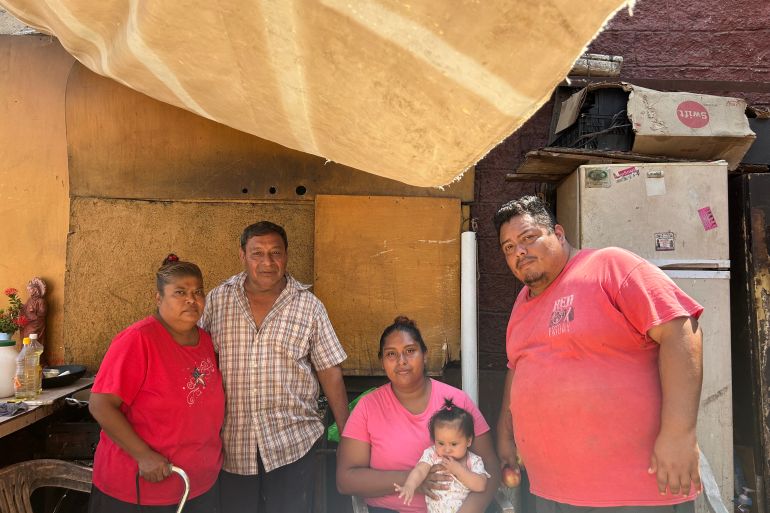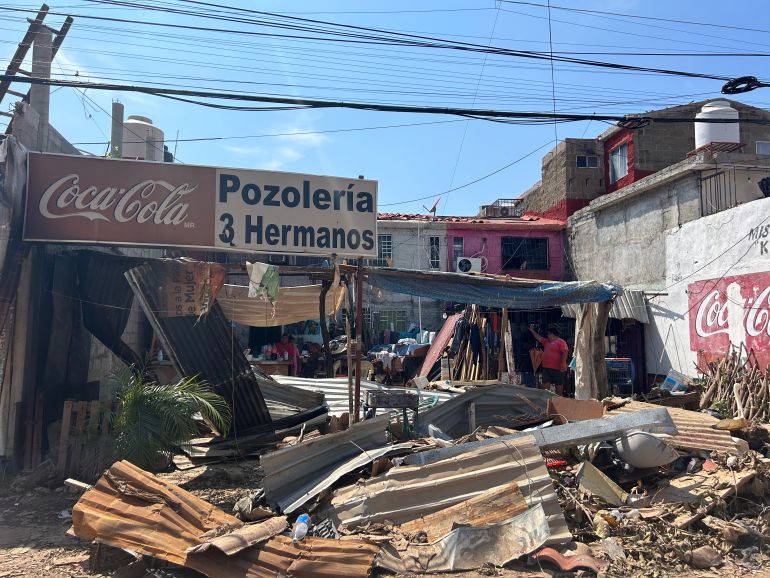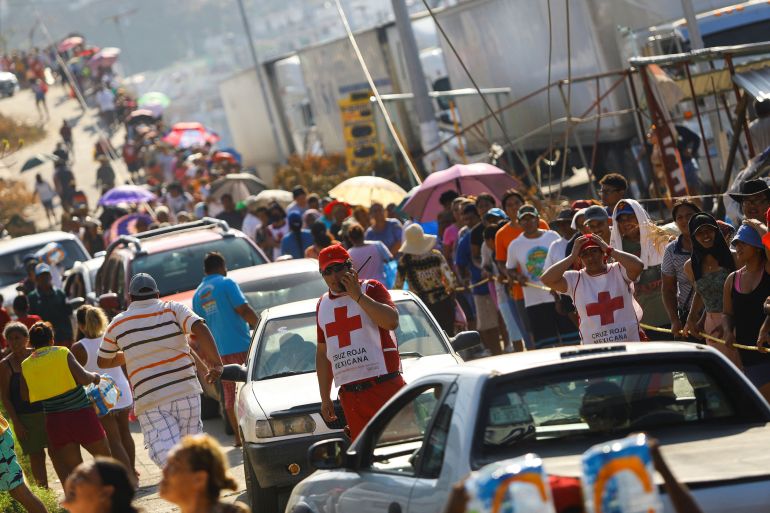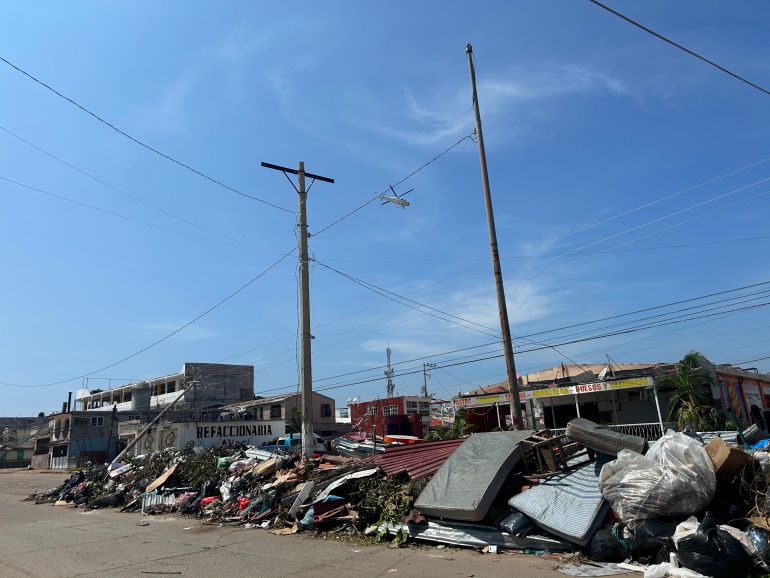Acapulco residents struggle to access food, medicine after Hurricane Otis
The Category 5 storm lashed the famed Mexican tourist city, leaving residents desperate for supplies, like insulin and food.



SOURCE: AL JAZEERA
The Category 5 storm lashed the famed Mexican tourist city, leaving residents desperate for supplies, like insulin and food.

The Transito family — Beatriz, Santiago, Lucia and Lucia's husband and baby daughter — stand in the wreckage of their home after Hurricane Otis
[Lillian Perlmutter/Al Jazeera]
Al Jazeera
Published On 4 Nov 2023
For 25 years, the Tres Hermanos Pozoleria in Acapulco, Mexico, served 64 litres a week of pozole: a rich, stomach-warming soup made of hominy corn.
It was a favourite neighbourhood haunt. Customers would belly up to the modest, brown-and-white tiled counter to order a bowl of soup, before settling into the dining tables nearby.
But on the morning of October 26, the Tres Hermanos Pozoleria disappeared. All that remained was its sign, inviting customers to a pile of rubble where tables and chairs once stood.
The wreckage at the restaurant reflected the devastation across the city as a whole. Acapulco suffered a direct hit from Hurricane Otis, a Category 5 storm that left at least 46 dead and 58 missing.
Just 16 hours before it made landfall, Otis was predicted to be a Category 1 storm, the lowest level on the five-tier scale. But the hurricane intensified rapidly, defying all forecasts.
When it struck Acapulco, it brought sustained winds of 270 kilometres (165 miles) per hour. Flood waters rose, power lines tumbled and the coastal city’s steep cliffs crumbled into mudslides.
The National Oceanic and Atmospheric Administration in the United States has called Otis the strongest hurricane to strike the Eastern Pacific since the advent of satellite forecasting.
“It was like a water tornado, spinning and eating things up,” said Lucia Transito, one of the owners of the Tres Hermanos Pozoleria. “We saw when everything was destroyed, but more than that, we heard it.”
The rapid acceleration of the hurricane’s power, fuelled in part by climate change, gave Acapulco residents little time to evacuate.
Published On 4 Nov 2023
For 25 years, the Tres Hermanos Pozoleria in Acapulco, Mexico, served 64 litres a week of pozole: a rich, stomach-warming soup made of hominy corn.
It was a favourite neighbourhood haunt. Customers would belly up to the modest, brown-and-white tiled counter to order a bowl of soup, before settling into the dining tables nearby.
But on the morning of October 26, the Tres Hermanos Pozoleria disappeared. All that remained was its sign, inviting customers to a pile of rubble where tables and chairs once stood.
The wreckage at the restaurant reflected the devastation across the city as a whole. Acapulco suffered a direct hit from Hurricane Otis, a Category 5 storm that left at least 46 dead and 58 missing.
Just 16 hours before it made landfall, Otis was predicted to be a Category 1 storm, the lowest level on the five-tier scale. But the hurricane intensified rapidly, defying all forecasts.
When it struck Acapulco, it brought sustained winds of 270 kilometres (165 miles) per hour. Flood waters rose, power lines tumbled and the coastal city’s steep cliffs crumbled into mudslides.
The National Oceanic and Atmospheric Administration in the United States has called Otis the strongest hurricane to strike the Eastern Pacific since the advent of satellite forecasting.
“It was like a water tornado, spinning and eating things up,” said Lucia Transito, one of the owners of the Tres Hermanos Pozoleria. “We saw when everything was destroyed, but more than that, we heard it.”
The rapid acceleration of the hurricane’s power, fuelled in part by climate change, gave Acapulco residents little time to evacuate.

Hurricane Otis destroyed the Transito family business, the Tres Hermanos Pozoleria in Acapulco, Mexico
[Lillian Perlmutter/Al Jazeera]
Three generations of the Transito family live together in a small, two-story house behind the restaurant. There’s Lucia, her father Santiago, her mother Beatriz Transito, her husband and their baby daughter.
On the night of October 25, they huddled together on the upper floor of their home, dodging pieces of window glass blown in by the wind.
When their neighbourhood, La Rinconada, flooded, the mud downstairs reached as high as their thighs. It took three days for the family to clear out all the muck. Their home was one of more than 200,000 that suffered serious damage in Acapulco.
But in the restaurant, the destruction was worse. Its corrugated metal roof lay twisted in pieces atop a nest of debris: broken wicker chairs, Coca-Cola bottles filled with mud, the shattered basin of a sink and shards of tile.
Though they once fed an entire neighbourhood, now the Transito family is itself without food. Seeing their need, former customers gifted them a bag of rice and one 11-litre jug of water. Lucia said she expects the supplies to last only a day.
But Lucia and her family are most worried about Beatriz, the matriarch of the family. She has diabetes, and at the time Al Jazeera visited their home, she had only one day’s worth of insulin left.
To make matters worse, the insulin has likely lost its potency, as the medicine needs to be refrigerated. La Rinconada has been without electricity for days.
“I don’t know what effect this will have on my body,” Beatriz said, as she prepared to take the insulin. Fear kept threatening to overwhelm her, as she grappled with the overall devastation.
“I look around at the damage, and suddenly it grabs me and I realize that this is actually real. I have to hold in my emotions,” she said. “We’re really living in hell, aren’t we?” Acapulco, once a tourist hub, sustained a direct hit from Hurricane Otis, a Category 5 storm [Lillian Perlmutter/Al Jazeera]
Acapulco, once a tourist hub, sustained a direct hit from Hurricane Otis, a Category 5 storm [Lillian Perlmutter/Al Jazeera]
Though the Mexican government sent a fleet of emergency response teams to Acapulco, none are stationed near La Rinconada. Plus, insulin is one of the few medicines they do not carry, due to the lack of refrigeration.
“People keep coming up and asking for it, but we have to turn them away,” said Nohemi Morales, a nurse working with the Mexican Health Department to assist with disaster relief in the city.
For Beatriz to find insulin, she would have to leave Acapulco, but the family does not have enough money to pay for her evacuation on top of the food they will need for the coming days.
Some families in the neighbourhood are living off what they can scavenge from destroyed supermarkets, according to the Transitos and their neighbours. Others are selling supplies at inflated prices.
Three days after the hurricane hit, the Mexican government sent 8,000 food rations and 16,000 litres of water to Acapulco to address immediate needs. But many in the city said they have yet to receive any food supplies or aid.
Hearing rumours that a military jeep would dispense rations to vulnerable people, seniors and young mothers, Lucia walked to the other side of her neighbourhood on October 28 to try to get some food.
Her father Santiago could not make the trip: His feet were dotted with sores from stepping on broken glass, and his only remaining shoes were a pair of flip-flops. And her mother Beatriz could not go either. Her knees are weak from her diabetes.
But after reaching the jeep, Lucia said she was turned away. She had waited in a long line in the heat, only to be told she needed to show her infant child as proof that she was among the qualifying residents.
“How was I going to stand there for hours with my baby?” Lucia said.
Three generations of the Transito family live together in a small, two-story house behind the restaurant. There’s Lucia, her father Santiago, her mother Beatriz Transito, her husband and their baby daughter.
On the night of October 25, they huddled together on the upper floor of their home, dodging pieces of window glass blown in by the wind.
When their neighbourhood, La Rinconada, flooded, the mud downstairs reached as high as their thighs. It took three days for the family to clear out all the muck. Their home was one of more than 200,000 that suffered serious damage in Acapulco.
But in the restaurant, the destruction was worse. Its corrugated metal roof lay twisted in pieces atop a nest of debris: broken wicker chairs, Coca-Cola bottles filled with mud, the shattered basin of a sink and shards of tile.
Though they once fed an entire neighbourhood, now the Transito family is itself without food. Seeing their need, former customers gifted them a bag of rice and one 11-litre jug of water. Lucia said she expects the supplies to last only a day.
But Lucia and her family are most worried about Beatriz, the matriarch of the family. She has diabetes, and at the time Al Jazeera visited their home, she had only one day’s worth of insulin left.
To make matters worse, the insulin has likely lost its potency, as the medicine needs to be refrigerated. La Rinconada has been without electricity for days.
“I don’t know what effect this will have on my body,” Beatriz said, as she prepared to take the insulin. Fear kept threatening to overwhelm her, as she grappled with the overall devastation.
“I look around at the damage, and suddenly it grabs me and I realize that this is actually real. I have to hold in my emotions,” she said. “We’re really living in hell, aren’t we?”
 Acapulco, once a tourist hub, sustained a direct hit from Hurricane Otis, a Category 5 storm [Lillian Perlmutter/Al Jazeera]
Acapulco, once a tourist hub, sustained a direct hit from Hurricane Otis, a Category 5 storm [Lillian Perlmutter/Al Jazeera]Though the Mexican government sent a fleet of emergency response teams to Acapulco, none are stationed near La Rinconada. Plus, insulin is one of the few medicines they do not carry, due to the lack of refrigeration.
“People keep coming up and asking for it, but we have to turn them away,” said Nohemi Morales, a nurse working with the Mexican Health Department to assist with disaster relief in the city.
For Beatriz to find insulin, she would have to leave Acapulco, but the family does not have enough money to pay for her evacuation on top of the food they will need for the coming days.
Some families in the neighbourhood are living off what they can scavenge from destroyed supermarkets, according to the Transitos and their neighbours. Others are selling supplies at inflated prices.
Three days after the hurricane hit, the Mexican government sent 8,000 food rations and 16,000 litres of water to Acapulco to address immediate needs. But many in the city said they have yet to receive any food supplies or aid.
Hearing rumours that a military jeep would dispense rations to vulnerable people, seniors and young mothers, Lucia walked to the other side of her neighbourhood on October 28 to try to get some food.
Her father Santiago could not make the trip: His feet were dotted with sores from stepping on broken glass, and his only remaining shoes were a pair of flip-flops. And her mother Beatriz could not go either. Her knees are weak from her diabetes.
But after reaching the jeep, Lucia said she was turned away. She had waited in a long line in the heat, only to be told she needed to show her infant child as proof that she was among the qualifying residents.
“How was I going to stand there for hours with my baby?” Lucia said.

Acapulco residents form a long line to receive drinking water from Red Cross workers on November 2 [Jose Luis Gonzalez/Reuters]
On November 3, over a week after the hurricane hit, Mexican President Andres Manuel Lopez Obrador announced that three million boxes of rations and over a million litres of water would be sent into Acapulco for 350,000 affected residents.
“We’re going to help everyone, but we had to help those most in need first,” he said in a press conference.
“We’re waiting for the government. They’re our only hope,” Beatriz said.
As they held out for aid, the Transito family considered using their last pesos to buy ingredients and sell the food they cooked, as they had before the hurricane.
“But all of our pots were carried away by the storm,” said Lucia. The pots still held green and white pozole from the day before.
On November 3, over a week after the hurricane hit, Mexican President Andres Manuel Lopez Obrador announced that three million boxes of rations and over a million litres of water would be sent into Acapulco for 350,000 affected residents.
“We’re going to help everyone, but we had to help those most in need first,” he said in a press conference.
“We’re waiting for the government. They’re our only hope,” Beatriz said.
As they held out for aid, the Transito family considered using their last pesos to buy ingredients and sell the food they cooked, as they had before the hurricane.
“But all of our pots were carried away by the storm,” said Lucia. The pots still held green and white pozole from the day before.
SOURCE: AL JAZEERA

Debris lies on La Angosta Beach, in the aftermath of Hurricane Otis, in Acapulco, Mexico, on Oct 30, 2023.
PHOTO: Reuters
PUBLISHED ON NOVEMBER 03, 2023
ACAPULCO, Mexico - A 35-year-old sea turtle refuge in Acapulco is fighting for its life after the most powerful hurricane on record to strike Mexico's Pacific coast tore it apart last week.
Campamento Tortuguero Playa Hermosa (Playa Hermosa Turtle Camp) has since the 1980s been working on Acapulco's beachfront to protect the marine reptiles, collecting their eggs so they can safely nest, hatch and return to the Pacific Ocean.
But it faces an uncertain future since Otis, a Category five hurricane, slammed into Acapulco on Oct 25 and devastated the camp and home of founder Monica Vallerino - alongside thousands of other dwellings in the city of nearly 900,000 people.
"We have a camp to protect the sea turtle, my mother has worked and fought for it for 35 years, but this time the hurricane destroyed our whole house, where we live with my daughters," said Michelle Montero, Vallerino's daughter.
Mexico's government this week launched a US$3.4 billion (S$4.5 billion) rescue plan in response to Otis, which is known to have killed nearly 50 people. Dozens more are still missing.
Olive ridley turtles visit the camp in the rainy season, and Vallerino was preparing for the arrival of the brown leatherback turtle in cooler waters when Otis struck.
Read Also

Mexico's Acapulco ravaged by looting after Hurricane Otis
"We were expecting a storm, but not one of such magnitude," she said. "Unfortunately, it hit us so fast that we didn't even have time to protect the nests."
Initially forecast just to become a tropical storm, Otis strengthened with a ferocity that stunned weather experts.
Vallerino hopes the camp can recover from the destruction so her family's work can go on.
"Sea turtles have been around since the time of the dinosaurs and are totally enigmatic animals," she said. "So we fight for them and want to keep preserving them on our planet."
Source: Reuters
SEE
'Nightmare': How Category 5 Hurricane Otis shocked forecasters and slammed a major city
Hurricane Otis and the Indifference Toward the Children of Acapulco
Hurricane Otis Slams Mexico in ‘Nightmare Scenario’ That Shocked Meteorologists
Hurricane Otis makes landfall near Acapulco as catastrophic Category 5 storm
No comments:
Post a Comment